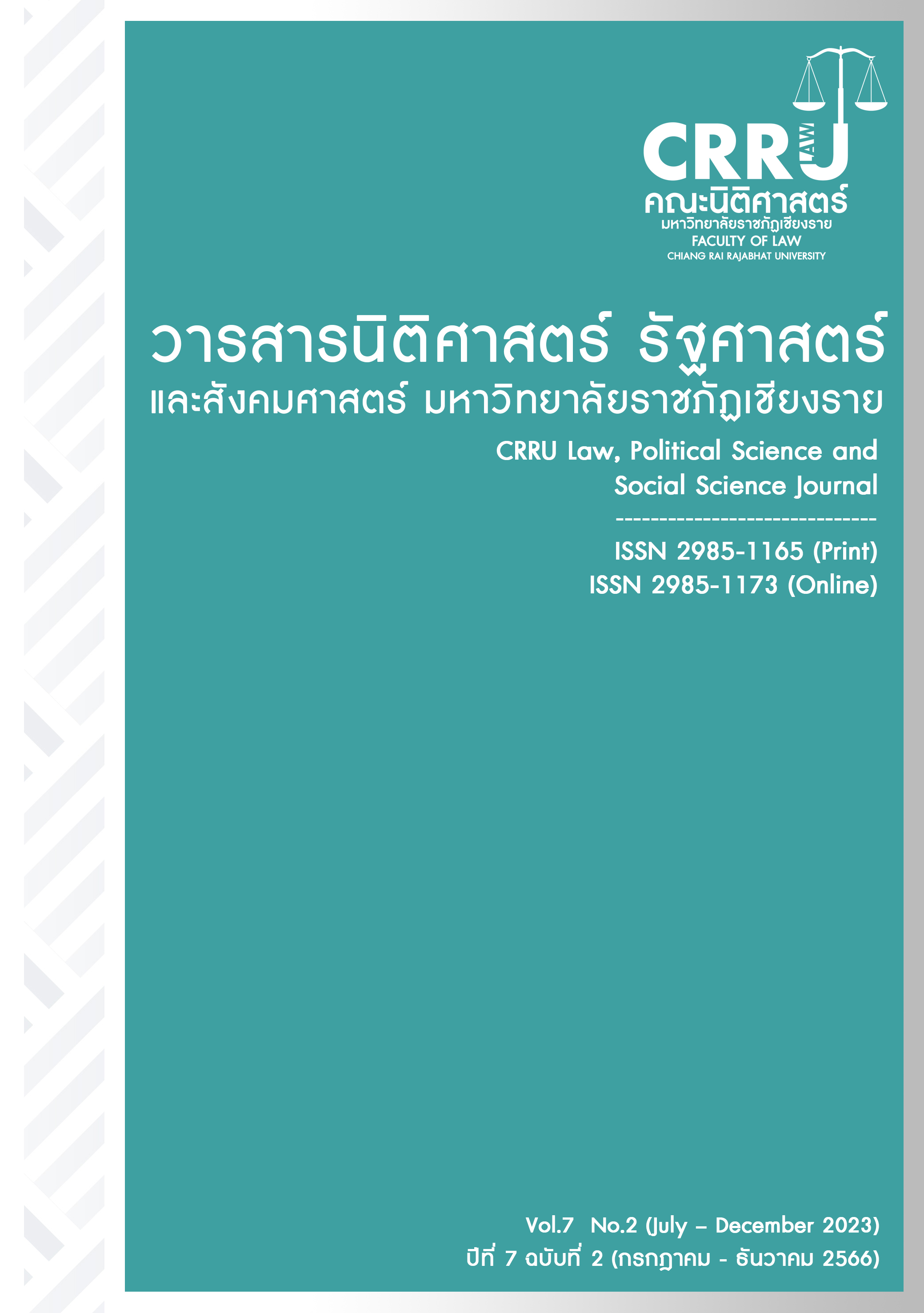Credit risk assessment of Thailand’s State-Owned Enterprises with the correlation of creditworthiness levels and debt repayment capacity.
Main Article Content
Abstract
The purposes of this research were to apply the results of the study of the relationship of creditworthiness levels and debt repayment capacity to credit risk assessment of Thailand’s state-owned enterprise (SOEs). The demographics were used Thailand’s SOEs that incurred debts recovered from Thailand’s Ministry of Finance (MOF) guaranties and on-lending loans from MOF in 2010-2021. This research was conducted a sequence of integrated research to collect quantitative and qualitative data accompanied by interviews with agencies involved in the credibility of SOEs. The statistics used to analyze data including percentages, averages and hypotheses tested by Logistic regression analysis (LOGIT).
This research determines indicators and weight values from the average of the Credit Rating Agency's indicators and weight values, related research and finds coefficients to determine risk’s weight value of each side of the risk by application from the Production function’s Cobb-Douglas. The results showed that indicators and weights to obtain creditworthiness levels include 1) Business risk (40%) 2) Financial risk (40%) and 3) Macro risk (20%). The debt repayment capacity measured by the Debt Service Coverage Ratio (DSCR). The results of the correlation findings showed that a probability level of CS and DSCR is 0.0000 indicates that are statistically significantly related. The coefficient value is -0.290665, which represents the relationship between two variables are very interrelated and correlated in opposite directions. The variable of the response variable (R-Squared) is 0.526985, which represents an independent variable. The research can explain variations in variable values as they are distributed around the mean and reflects the possibility of default (PD) of SOEs to apply credit risk management.
The results of this research can be applied as a credit risk assessment tool both of internal-external factors and risk of guarantees debt and on-lending debt. Also, can be used as a policy recommendation and guideline for improving guidelines, regulations and laws relating to the determination of rates, fees, guarantees and on-lending as well as being able to serve as a guideline for the development and efficiency of the operation of SOEs to more modern and concrete.
Article Details
References
ธีรัชย์ อัตนวานิช. “การพัฒนาแบบจำลองสำหรับการบริหารหนี้สาธารณะ.” ผลงานวิชาการ สำนักงานบริหารหนี้สาธารณะ กระทรวงการคลัง, (2552): 120.
ปราณิศา ชมทรัพย์. “ปัจจัยที่มีผลต่อการตัดสินใจซื้อกรมธรรม์ประกันภัยในเขตกรุงเทพมหานครและปริมณฑล.” วิทยานิพนธ์เศรษฐศาสตร์มหาบัณฑิต สาขาเศรษฐศาสตร์ธุรกิจ มหาวิทยาลัยเกษตรศาสตร์, 2564.
เปรมจิต เสาวคนธ์ และปัทมา โกเมนท์จำรัส. การวิเคราะห์ฟังก์ชั่นการผลิตเพื่อเป็นแนวทางในการกำหนดนโยบายเศรษฐกิจของรัฐบาล. กรุงเทพฯ: มหาวิทยาลัยศรีปทุม, 2546.
พฤทธ์สรรค์ สุทธิไชยเมธี. สถิติขั้นสูงเพื่อการวิจัยเชิงปริมาณทางสังคมศาสตร์. กรุงเทพฯ: สำนักพิมพ์ซีเอ็ด, 2563.
สงกรานต์ สมบุญ. ระบบการให้คะแนนเครดิตสำหรับการบริหารความเสี่ยงในพอร์ตสินเชื่อเพื่อการเกษตรของตลาดการเงินไทยชนบท. กรุงเทพฯ: เกษตรศาสตร์, 2558.
สำนักงานบริหารหนี้สาธารณะ. กฎกระทรวงกำหนดหลักเกณฑ์ วิธีการและเงื่อนไขการให้กู้ต่อของกระทรวงการคลัง พ.ศ. 2551. กรุงเทพฯ: สำนักงานบริหารหนี้สาธารณะ, กระทรวงการคลัง, 2551.
สำนักงานบริหารหนี้สาธารณะ. กฎกระทรวงกำหนดอัตราและเงื่อนไขการเรียกเก็บค่าธรรมเนียมการค้ำประกันของกระทรวงการคลัง พ.ศ. 2551. กรุงเทพฯ: สำนักงานบริหารหนี้สาธารณะ กระทรวงการคลัง, 2551.
สำนักงานบริหารหนี้สาธารณะ. กฎกระทรวงกำหนดอัตราและเงื่อนไขการเรียกเก็บดอกเบี้ยและค่าธรรมเนียมการให้กู้ต่อของกระทรวงการคลัง พ.ศ. 2551. กรุงเทพฯ: สำนักงานบริหารหนี้สาธารณะ กระทรวงการคลัง, 2551.
สำนักงานบริหารหนี้สาธารณะ. ประกาศสำนักงานบริหารหนี้สาธารณะเรื่อง หลักเกณฑ์และวิธีการประเมินระดับความน่าเชื่อถือของรัฐวิสาหกิจและสถาบันการเงินภาครัฐ. กรุงเทพฯ: สำนักงานบริหารหนี้สาธารณะ กระทรวงการคลัง, 2551.
อโนทัย พุทธาวี จิตรภณ หรูเจริญพรพานิช เพ็ญสิริ บำรุงเชาว์เกษม และชินวัฒน์ เทพหัสดิน ณ อยุธยา. รูปแบบการให้คะแนนเครดิต: เครื่องมือในการประเมินคุณภาพสินเชื่อ. กรุงเทพฯ: ธนาคารแห่งประเทศไทย, 2561.
Abdou, H. and Pointon, J., “Credit scoring, statistical techniques and evaluation criteria: review of the literature. Intelligent System in Accounting.” Journal of Finance & Management (April, 2011): 59-88.
Dominic Joseph. “Predicting credit default probabilities using Baysian Statistics and Monte-Carlo Simulations,”. Master’s thisis, Cornell University, 2021.
Moudud, A., and Carling, K. “Review of the literature on credit risk modeling: Development of the past 10 years” Banks and Bank Systems Journal (October 7, 2010): 47-60.
Setiawan, A., D. “The effect of financial leverage on debt repayment capacity: Evidence from listed shipping company in Indonesia,” Hasanuddin Economics and Business review (October, 2018): 113-122.
Sulistyo, B., Darmayana, R.A., Mohammad, M. and Ibrahim, R, “Article Key Performance Indicators of Indonesia State-Owned Enterprise - a Model Using BSC and MBPE.” International Journal of Integrated Engineering (April, 2020): 1-7.
The World Bank Group. Credit Scoring Approaches Guidelines. 2019.
World Bank. Contingent Liabilities Risk Management: A Credit Risk Analysis Framework for Sovereign Guarantees and On-Lending (Country Experiences from Colombia, Indonesia, Sweden and Turkey : Policy Research Working Paper. Washington, DC: World Bank, 2016.
Wharton Financial Institution. Deposit Insurance and Risk Management: How Much? How Safe? Who Pays?, : Working Paper. Pennsylvania : The University of Pennsylvania, 2002.


